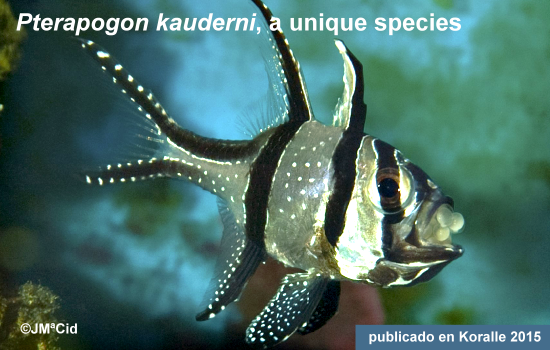Breeding Pterapogon kauderni
Author: Jose Maria Cid RuizAbstract
This video describes in a didactic way the main keys to achieve success in the maintenance, reproduction and development of larvae of the cardinal fish of Banggai (Pterapogon kauderni). Throughout the film, we see the ideal characteristics of the marine aquarium for maintenance; witnessing their curious courtship and spawning, and the spectacular period of mouthbrooding that carried out the males of this species. We will attend the birth of their larvae and their first food captures and, thus we will continue with the rest of their development until we see the beautiful schools of juveniles born in captivity.
Pterapogon kauderni is a good paradigm about how fish farming of ornamental fish could have a positive impact on the survival of certain threatened species, offering captive-born specimens to the aquarium fish market that would relieve pressure on native populations. We will observe how the larvae are collected and transferred for their development, to an aquarium of about 10 L. equipped simply with a line of soft aeration and several objects on the bottom, simulating “artificial hedgehogs”. As a first food, they receive newborn nauplius of Artemia salina, enriched with essential fatty acids: the HUFA Ω-3 a. docosahexanoic acid (DHA) and a. Eicosapentanoic acid (EPA) and Ω-6 a. arachidonic (ARA).
The video emphasizes the fact that its reproduction in captivity is viable and relatively simpler than that of other tropical marine species maintained in the aquarium and therefore, generates a great opportunity to improve the species’ medium-term survival expectations. This opportunity inevitably passes by replacing in the ornamental fish trade the specimens collected in the wild by specimens bred in captivity.
Resumen
Este vídeo describe de forma didáctica las principales claves para lograr tener éxito en el mantenimiento, reproducción y desarrollo de larvas del pez cardenal de Banggai (Pterapogon kauderni). A lo largo del documental, observaremos las características idóneas del acuario marino para su mantenimiento, presenciaremos su curioso cortejo y desove, así como, el espectacular periodo de incubación bucal que, llevan a cabo los machos de esta especie. Asistiremos al nacimiento de sus larvas y a sus primeras capturas de alimento y, así seguiremos con el resto de su desarrollo hasta ver los hermosos cardúmenes de juveniles nacidos en cautividad.
Pterapogon kauderni constituye un buen paradigma acerca de cómo la piscicultura de peces ornamentales podría tener un impacto positivo sobre la supervivencia de determinadas especies amenazadas, ofreciendo al mercado de peces de acuario, ejemplares nacidos en cautividad que aliviarían la presión sobre las poblaciones autóctonas. Observaremos como las larvas son recolectadas y trasladadas para su desarrollo, a un acuario de unos 10 L. dotado simplemente con una línea de aireación suave y de varios objetos sobre el fondo, simulando “erizos artificiales”. Como primer alimento, se les ofrece nauplius recién nacidos de Artemia salina, enriquecidos con ácidos grasos esenciales: los HUFA Ω-3 a. docosahexanoico (DHA) y a. eicosapentanoico (EPA) y el Ω-6 a. araquidónico (ARA).
El vídeo enfatiza el hecho de que su reproducción en cautividad sea viable y relativamente más sencilla que el de otras especies marinas tropicales mantenidas en acuario y por tanto, genera una gran oportunidad para mejorar las expectativas de supervivencia a medio plazo de la especie. Esta oportunidad, pasa ineludiblemente por sustituir en el comercio de peces ornamentales los ejemplares recolectados en la naturaleza por especímenes criados en cautividad.




